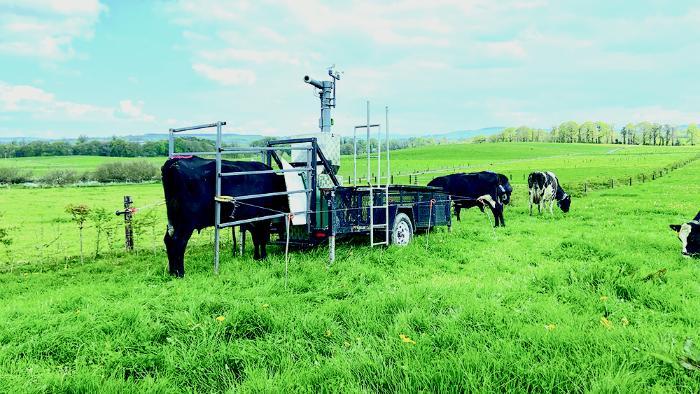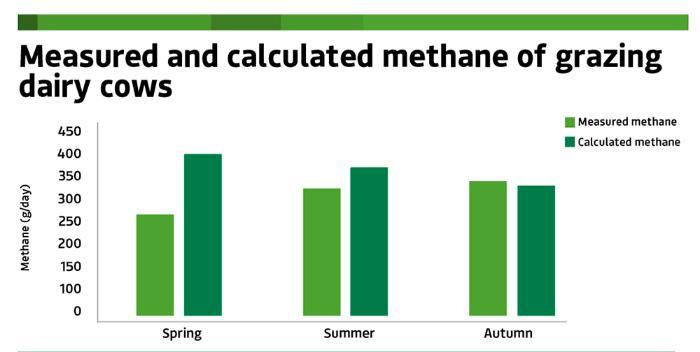04 March 2025
Enteric methane: generating new baselines

Improving enteric methane emission estimates from ruminant livestock is an important step towards more informed decision- making on appropriate mitigation strategies.
Agriculture is the largest contributor to Ireland’s greenhouse gas (GHG) emissions profile, with enteric methane from ruminant livestock accounting for approximately 63% of all agricultural GHG emissions. Various strategies offer potential to reduce enteric methane emissions, such as optimising diets and animal breeding. Accurately quantifying these emissions is important for the agricultural sector, as it enables more informed decision-making on mitigation strategies at a national level.
Localised data
Models of varying complexity are used to estimate enteric methane emissions from ruminant livestock within different jurisdictions. In Ireland, the agricultural sector makes its estimations using tier-two empirical prediction models from the Intergovernmental Panel on Climate Change (IPCC), explains Ben Lahart, Research Officer at Teagasc Moorepark.
The methane conversion factor for grazing Irish dairy cows is approx. 8% lower than the recommended international value
“These models calculate animal gross energy intake based on energetic needs for growth, milk production, pregnancy and maintenance. This estimated feed intake is then multiplied by a methane conversion factor to estimate daily methane emissions for different categories of ruminant livestock.”
For dairy and beef cattle grazing on pasture, enteric methane emissions are calculated using an international methane conversion factor recommended by the IPCC. When cattle are housed and fed a silage-based diet, the inventory uses an equation from historic research data to calculate the methane conversion factor. For sheep, emissions are estimated using international methane conversion factors for both grazing and housed conditions.
“However, the IPCC states that it’s good practice to utilise country-specific data where possible,” Ben notes. “Therefore, further research is required to determine methane conversion factors specific to Irish ruminants under grass-based systems.”
Country-specific methane conversion factors improve the accuracy of estimates by accounting for localised factors such as diet, livestock type and management practices. This reduces uncertainty and improves the reliability of national GHG inventories, enabling the development of targeted emission mitigation strategies.
Seasonal variation
To evaluate enteric methane emissions under Irish conditions, Teagasc uses GreenFeed units, Ben explains.
“Animals are enticed to visit these units roughly three times per day by offering a small portion of concentrate feed. When an animal enters the machine, an air sample is obtained from the animal, which is then measured for methane content.”
Direct measures of methane output within localised conditions can also reveal new insights into the dynamics of methane output. Recent research conducted by Teagasc and VistaMilk has revealed significant variation in methane emissions from dairy cows within spring-calving pasture-based systems. Notably, lower methane emissions are observed in the spring, when cows are at peak milk production.
As the grazing season progresses, methane output increases while milk solids production declines, coinciding with deteriorating pasture quality and advancing lactation. In contrast, methane emissions were previously estimated to follow the same profile as feed intake, peaking in early lactation during the spring period.
Substantial differences can occur when comparing measured methane output values in Irish conditions against values calculated using international default methane conversion factors, particularly during the spring grazing period, Ben points out.
“Furthermore, when all data is collated from grazing dairy cows under Irish conditions, the methane conversion factor for Irish dairy cows is approximately 8% lower than the international value recommended by the IPCC. However, it is important to note that further data is needed for other ruminant livestock categories such as beef and sheep, to ensure that methane conversion factors are accurately estimated across all species.”
Improving accuracy
In 2023, the Department of Agriculture, Food and the Marine and the Department of Agriculture, Environment and Rural Affairs funded the Rumenventory project to develop more accurate methane conversion factors for ruminant livestock under Irish conditions.
Led by Teagasc in collaboration with University College Dublin, the Irish Cattle Breeding Federation and the Agri-Food and Biosciences Institute, the project aims to advance research on enteric methane emissions in Ireland.
The project will evaluate methane emissions across dairy, beef and sheep systems using GreenFeed technology. Field experiments will take place at Teagasc research centres in Moorepark, Grange, and Athenry, along with University College Dublin’s Lyons Research Farm, explains Ben.
“These experiments will quantify methane output under different nutritional regimes and growth stages, providing essential data for national inventories. Additionally, the Agri-Food and Biosciences Institute will assess the accuracy of GreenFeed technology by comparing its results with those from the gold-standard respiration chamber method.”

Measured and calculated methane of grazing dairy cows.
Advancing models
Another important aspect of the project is evaluating the impact of improved genetic merit on methane emissions. Specifically, it will focus on the Economic Breeding Index for dairy cattle and the EuroStar indexes for beef and sheep. This will help determine if genetic selection for traits that improve livestock productivity and efficiency could also reduce methane emissions, and whether current inventory models need to be revised to account for such genetic effects.
In the latter stages of the project, data will be compiled by the Irish Cattle Breeding Federation to create Ireland’s first large-scale enteric methane database. This database will capture the variation in methane emissions across different production systems, allowing for more accurate methane conversion factors to be generated for ruminant livestock in Ireland.
“The data will also support the development of advanced IPCC tier-three prediction models that account for the effects of diet and genetics, improving the accuracy of methane emission estimates and reducing uncertainty in national inventories,” Ben concludes.
“Ultimately, this will lead to more precise predictions of enteric methane emissions
in Ireland, enabling the agricultural sector and national inventory to make better-informed decisions on methane mitigation strategies.”
This article was first published in TResearch Spring 2025
Funding: The dairy research results in this article were funded by Tírlan, Kerry, Carbery, Ornua, Dairygold and Nutribio through VistaMilk (Research Ireland). The Rumenventory project was funded by the Department of Agriculture, Food and Marine and the Department of Agriculture, Environment and Rural Affairs.
Acknowledgements: Noirin McHugh, Hazel Costigan and Eoin Dunne are gratefully acknowledged for their contributions to the research. This works forms part of the Teagasc Climate Centre.
Contributors
- Ben Lahart, Research Officer, Teagasc Moorepark, Fermoy. ben.lahart@teagasc.ie
- Jonathan Herron, Research Officer, Teagasc Moorepark, Fermoy.
- Peter Doyle, Research Officer, Teagasc Grange, Dunsany.
- Fiona McGovern, Research Officer, Teagasc, Mellows Campus, Athenry.
